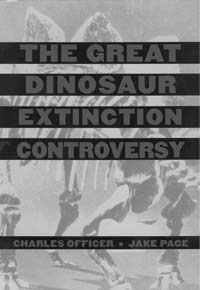
The Great Dinosaur Extinction Controversy, Charles Officer & Jake Page, Addison-Wesley, Reading, MA, 1996; 222 pages, ISBN 0-201-48384-x, hardcover, $25.00.
In 1980 Nobel physicist Luis Alvarez announced his theory that about 65 million years ago a giant meteorite, 10 kilometers in diameter, crashed into the earth at thousands of miles an hour, raising an immense dust cloud that blocked out the sun for many years and led to the demise of the dinosaurs and many other forms of life. This exciting theory was vigorously promoted in certain scientific journals, was eagerly taken up by the media, and quickly became the hottest scientific "fact." However, contrary to the impression most people may have, the majority of scientists oppose the theory, and research has shown that it is wrong.
In The Great Dinosaur Extinction Controversy, Charles Officer, a geologist, and Jake Page, a science writer, present a highly engaging account of how the hypothesis became so widespread, and of the acrimonious controversy it has aroused among scientists; they characterize the whole episode as "pathological science." They also present an alternative explanation for the mass extinctions that took place at the end of the Cretaceous and beginning of the Tertiary (the "K-T boundary"). About 50% of all species died out at this time (marine organisms being the worst hit), but these extinctions began many millions of years before the K-T boundary, accelerated as the transition approached, and in some cases continued into the Tertiary. So even if an impact did occur around K-T times, it was no more than a sidelight.

The two main pieces of evidence usually cited in support of the impact theory are the high levels of iridium and the "shocked" quartz found in K-T strata at various geographical locations. However, research has shown that these anomalies were most likely the result of the long period of intense global volcanism that marked the end of the Cretaceous. Volcanism of unprecedented magnitude also occurred at the Permian-Triassic boundary (250 million years ago according to scientific dating), when 70 to 80% of all existing species, and over 90% of marine species became extinct. It was these earth-bred cataclysms, together with the far-reaching climatic changes that ensued, and changes in sea level (or land elevation), that were the main cause of the extinctions.
Impact enthusiasts have been forced to make several ad hoc adjustments to the original hypothesis in an attempt to accommodate the observed facts. For instance, some have proposed that there may have been 6 to 10 cometary impacts over a 3-million year period, while others have suggested a series of impacts in the course of just a year or so, some hitting continents and others oceans, but none of these alternatives can explain all the evidence. So far not a single impact crater of the right size and age has been found. A huge "crater," 200 km in diameter, exists on Mexico's Yucatan peninsula and appears to be of the right age, but geological surveys point to a volcanic origin and rule out an impact origin. A meteorite or asteroid large enough to produce a crater 200 km across would have blasted out at least 10 km of the upper crust, destroying the uppermost Cretaceous layers, whereas the Yucatan structure is only a fraction of this depth and the upper Cretaceous layers are still intact. About 100 genuine meteorite craters of significant size are known, dating from various periods of the earth's history, but none has been found to be associated with any extinctions.
Although the authors subject the impact theory to critical scrutiny, they take for granted a number of other scientific theories that can also be challenged -- including radiometric dating, magnetic reversals, continental drift (plate tectonics), and the current model of the earth's interior. (1) Nor do they question the role supposedly played by "chance" in evolutionary and other natural processes. From a theosophical viewpoint, there is nothing "random" or "accidental" about natural catastrophes; they arise from the tensions that build up in the inner, causal realms, and are the karmic effects of the histories of all the entities of different classes involved in them. Plant or animal species that are unable to adapt sufficiently to changing environmental conditions, and no longer provide suitable vehicles for the evolutionary experience of the monads or consciousness-centers embodying in that kingdom, eventually die out, and their place is taken by more appropriate forms. (2)
The following, written by H. P. Blavatsky in 1888, gives pause for thought:
Science confesses its ignorance of the cause producing climatic vicissitudes and . . . changes in the axial direction, which are always followed by these vicissitudes; nor does it seem so sure of the axial changes. And being unable to account for them, it is prepared rather to deny the axial phenomena altogether, than admit the intelligent Karmic hand and law which alone could reasonably explain such sudden changes and their results. It has tried to account for them by various more or less fantastic speculations; one of which would be the sudden, and as imaginary, collision of our earth with a comet . . . , as the cause of all the geological revolutions. But we prefer holding to our esoteric explanation, since Fohat (3) is as good as any comet, having, in addition, universal intelligence to guide him. -- The Secret Doctrine 2:329-30
FOOTNOTES:
1. See the four catalogs of geological anomalies compiled by W. R. Corliss (Source- book Project, P. O. Box 107, Glen Arm, MD 21057). (return to text)
2. See "The Rhythms of Life," Sunrise, June/July 1994. (return to text)
3. Fohat is a collective name for the forces of nature, which work from the inner planes outwards into the physical world -- not randomly but under the direction of the "laws" of nature, i.e., the will and consciousness of higher intelligences. -- DP (return to text)